Family : Rosaceae
Classification : Wild Rose

Text © Prof. Franca Bessi

English translation by Mario Beltramini
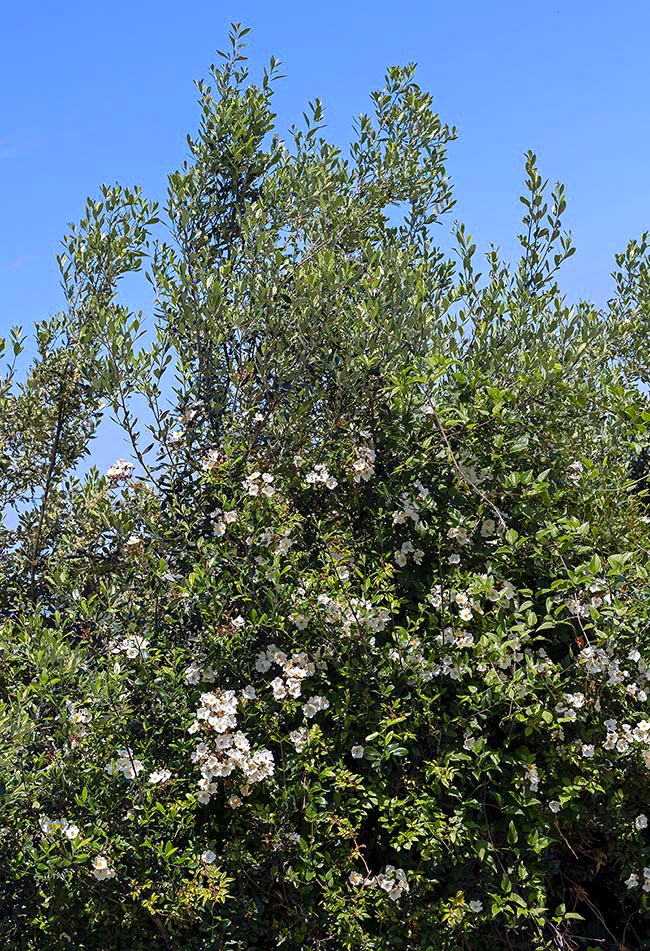
Rosa sempervirens is a steno mediterranean sarmentose species with a range coinciding with the olive tree © Giuseppe Mazza
Rosa sempervirens was described by Linnaeus (Sp.Pl.1:492) in 1753 as a rose with prickly stem and leaves having five persistent glabrous leaflets hence the Latin specific name sempervirens (evergreen).
The Author did report it as endemic to Germany, but the chorotype of Rosa sempervirens is steno mediterranean with a distribution area coinciding with that of the olive tree.
Heliophilous and xerophilous plant, is a member of the Mediterranean maquis and usually does not exceed the 800-900 m of altitude (above, found on the Etna); in northern France is found in the valleys of the rivers and their tributaries flowing down to the Ocean.
The vulgar names of this species are not particularly imaginative as, mainly, refer to the period of blooming or to the characteristics of the leaves, glossy and not deciduous: Rosa di San Giovanni and Rosa lustra (Italy); Rosal siempre verde, Rosa mosqueta común (Spain); Evergreen Rose (England); Rosier toujours vert (France); Immergrüne Rose (Germany).
The botanist Gaetano Savi (1769-1844), roughly agreeing with the common name of the Spaniards, recognized the name of Rosa dommaschina salvatica and in 1811 included it in the “species of Roses (wild, that) besides being suitable for fences, can be also employed as ornamental plants, being really beautiful due to their foliage and their flowering”.
This rose is characterized by a calyx with a narrow orifice disc, by the pubescent stalks merged in a style column elongated-concrescent exceeding the stamens (which places it in the section of the Synstylae, that is of the roses having the styles united in column, as the etymology of the word suggests) and to be an evergreen with the intermediate leaves of the floriferous branches formed by five leaflets.
These, 5(-7), coriaceous and glabrous with simply serrated edges, are, above, darker and glossy and below paler with the curved apices, the leaflets on the rachis are arranged scararly: smaller those close to the stipules and bigger and longer the apical one. The thorns are from slightly curved to, sometimes, more falcate.
The flowers, simple, have golden stamens and white petals, widely obovate and heart-shaped with laterally curved edges when flowering is advanced. The corollas, more or less fragrant, with a diameter of 3-5 cm are supported by glandular pedicels in having few flowers inflorescences (3-5); the receptacle has variable shape usually ovoid and the oval sepals are entire (only the outer ones can display small, inconspicuous, lobes), sharp or acute and are deciduous.
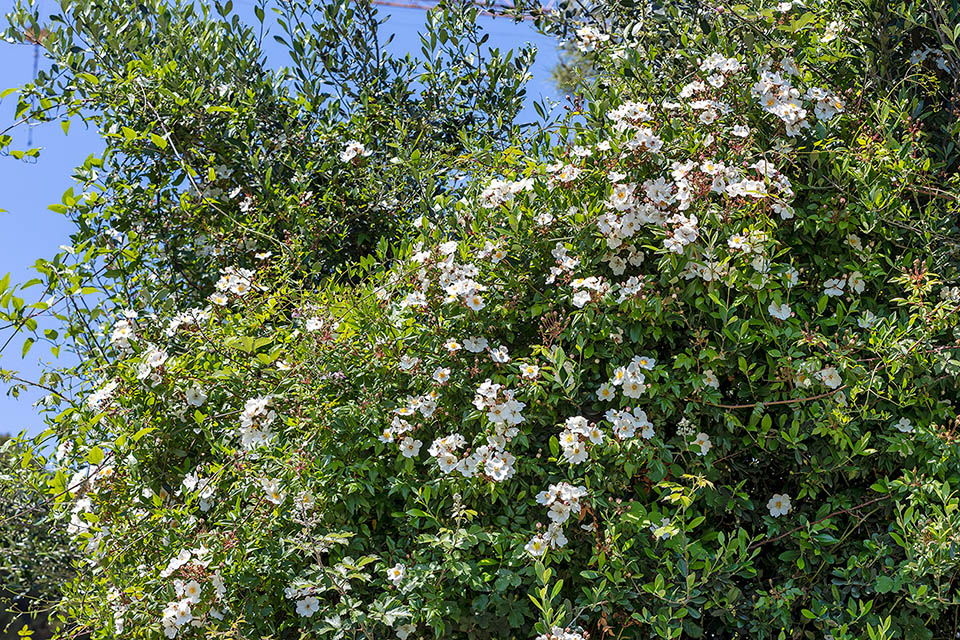
Thanks to the rather long stems internodes, it is naturally able to garland all what surrounds it © Giuseppe Mazza
The inflorescences, sub-corymbs with persistent bracteoles and bracts, are borne on short lateral shoots. Blooming occurs from spring up to early summer (May-June). The rosehips are small and globular and, depending on the intraspecific variability, can be variously glandular and, at times, on their top remains visible the stylar column now withered. Ripening takes place in September-October and the colour of the false fruits may change from brick red to very dark maroon.
Defined bushy Phanerophyte and sarmentose Phanerophyte it may present with a prostate as well as ascending posture and tends to cover, thanks to its slender and sarmentose branches, the woody elements and possible artifacts/ruins present in its environment. The characteristic of not being able to hold themselves up «not able to sustaine themselves without some helpe» was highlighted also on “Paradisi in sole, paradisus terrestris” (1629, p.420) by John Parkinson.
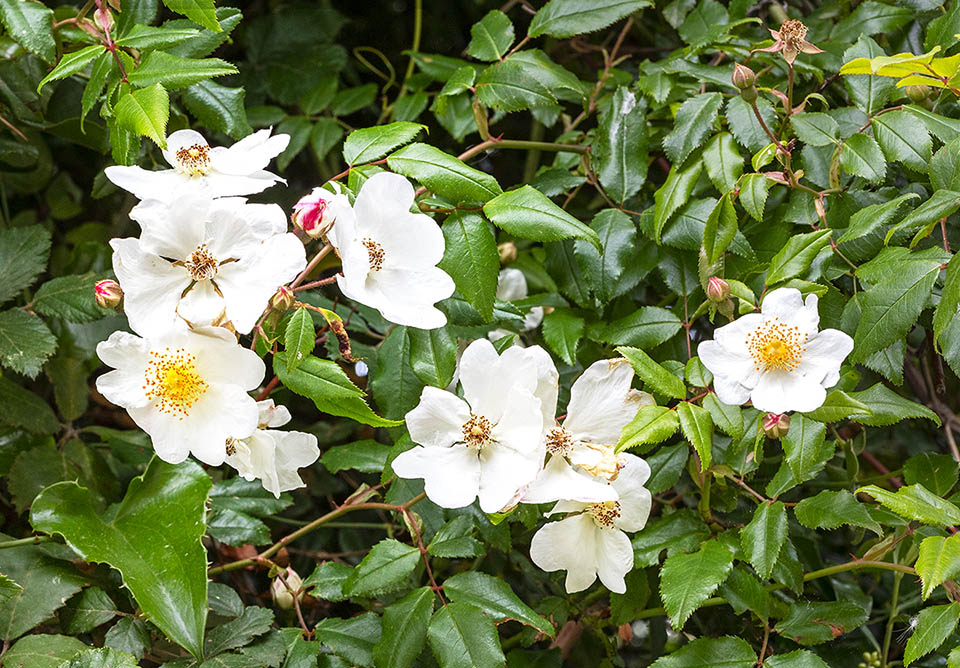
Due to the shine of its perennial leaves, it is valuable in the low cost maintenance arrangements. Blooming, though short lasting, has a good ornamental effect © G. Mazza
In ancient times, thanks to its development that is on average indicated on 5-6 m of height, it was utilized for the trellises and, introduced during the first half of the XVII century in England, was still employed as ornamental climber: a rose to be used as rambler, mainly to arrange on trees or to be drawn in pyramid. Nowadays it is still recommended, provided adequately supported, to cover the lateral edges (fences) and the boundary walls of the gardens: when grown as espalier must be pruned as any other sarmentose rose, not forgetting the necessary precautions not being exempt from phytotherapies. It prefers the fertile and well drained soils in sheltered, sunny positions or in slight shade.
The variability of the morphological characters within this taxon made believe in the past that also Rosa sempervirens could be subdivided in more species, rightly starting from the non-constancy among those considered as diagnostic: among the botanist who deemed appropriate to suggest the detachment of new species from Rosa sempervirens L. was the the French Michel Gandoger (1850-1926).
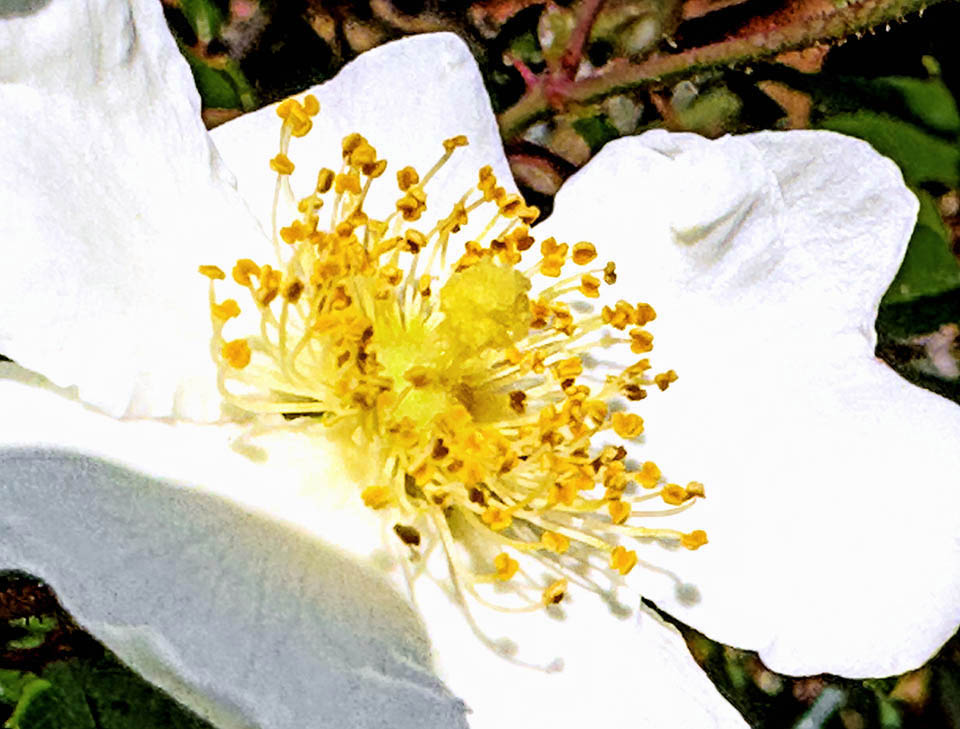
It is a simple rose, with 5 petals, and here are visible the characteristic concrescent columnar styles © Giuseppe Mazza
As an instance, were separated Rosa scandens Mill. that presents with slightly scented flowers and ovoid rosehip and Rosa prostrata DC. that has glabrous styles like Rosa moschata. In “Matériaux pour servir a l’histoire des roses”François Crépin expressed himself negatively against the dismemberment of the Linnaeian taxon.
Rosa sempervirens has individuals with diploid 2n=14, triploid 2n=21, and tetraploid 2n=28 chromosomal set. Besides being known as Rosa scandens and Rosa prostrata, it was also indicated as Ripartia sempervirens (L.) Gand. and Rosa alba All. (illegitimate name); presently POWO (Plants of the World Online of the Kew Royal Botanic Gardens) grants it 91 synonyms, whilst WFO (World Flora Online) recognizes 48.
Thanks to its qualities it was chosen by Antoine Jacques (1782-1866), head gardener to the Duke of Orléans at Neuilly-sur-Seine, as parent species from which to develop a series of sarmentose hybrids that now are listed as Hybrid Sempervirens (HSem) by the American Rose Society.
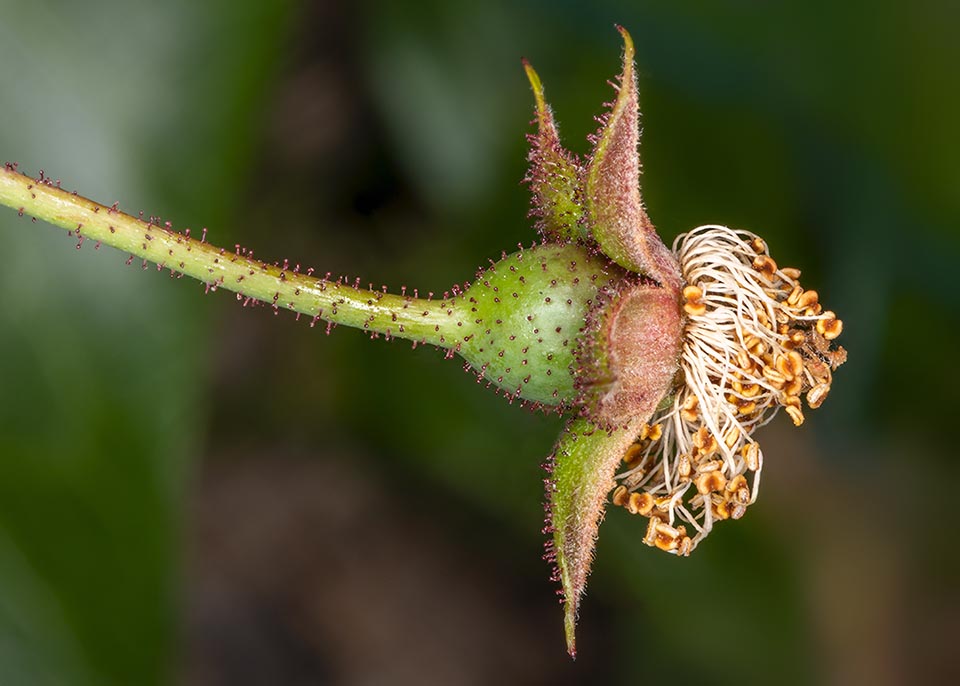
On the pedicel are evident the reddish stipitate small glands. The sepals, here evident, will fall when the rosehip will ripen © Giuseppe Mazza
Of Jacques’ cultivars are still found on the market:
Rosa ‘Félicité et Perpétue’ (1828), very vigorous plant with rich inflorescences of rounded flowers that open in rich rosette corollas of fleshy-white colour;
Rosa ‘Flore’ (1829), very vigorous plant with double cupped flowers of pink colour with more intensely coloured centre;
Rosa ‘Princesse Marie’ (1829), (1829), very vigorous plant with inflorescences of pink bud opening in medium sized corollas turning to white and fragrant;
Rosa ‘Reine des Belges’ (1832), ‘excessively’ vigorous plant with inflorescences of white flat flowers.
→ History of the rose : from the Wild Roses towards a perfect rose.
→ To appreciate the biodiversity of roses, please click here.
